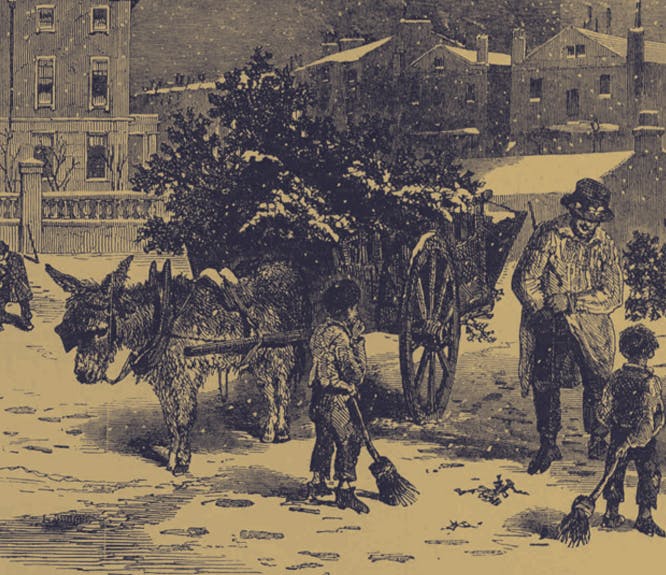Paul Revere may have failed without the help of these 12 everyday people
5-6 minute read
By The Findmypast Team | July 1, 2020

The amazing true story of the people who helped Paul Revere along his midnight ride.
The Midnight Ride of Paul Revere is one of the most well-known stories in American history. But good old Paul always gets all the credit, and he should share it.
During his daring ride to alarm the countryside that "the Regulars are coming," Paul Revere received crucial help from the people of Massachusetts, some of whom may even be your ancestors.
Discover ancestors online
Enter a few details to see your family's records at your fingertips.
These 12 people were truly lucky to participate in a single event of such importance. But their agency in shaping history reminds us that in some way all of our ancestors contributed to the times they lived in, whether it was exemplifying a historical trend or their proximity to a well-known event. The story that follows will really get you thinking - what could your family have been involved in?
The REAL story of Paul Revere's Ride
In his landmark book, Paul Revere's Ride, historian David Hackett Fischer tackles several myths that have been associated with the Midnight Ride throughout history.
Perhaps the most enduring and widespread is what Fischer refers to as "the myth of the lone rider" - one propagated by the most famous piece of popular culture about the event:
""Listen my children and you shall hear,
Of the midnight ride of Paul Revere,
On the eighteenth of April, in Seventy-five;
Hardly a man is now alive
Who remembers that famous day and year.""
Many of us have fond (or not so fond) memories of memorizing this verse in grade school.
Henry Wadsworth Longfellow's poem, published in The Atlantic in 1861, took the country by storm. Shaped by the culture of the times, the poem painted Revere as a sole actor, which endured even though it wasn't accurate due to the poem's fame.
Who else was involved in Paul Revere's journey?
Just because he didn't act alone doesn't make his feat any less amazing. Paul Revere was a true patriot and an accomplished man - he was one of the most well-connected people in Boston and the surrounding countryside. Simply put, he knew everyone.
And this is what makes him so special, and why he ultimately was the only one who could have succeeded that night. But contrary to the popular conception of the event, his connections were the crucial factor to success.
Revere knew many of the people who helped him out, in significant ways or simply through acquaintance. Some came to him and offered their help; others Revere sought out himself.
This was perhaps Revere's most significant talent - he knew the right Massachusetts community leaders to find on his ride. He efficiently raised the alarm through the countryside by finding just the right person in each village. As the community leader would alert his town, Revere was already on his way to the next one.
That's the other famous phrase everyone knows about that ride of Paul Revere. By his own account,
""If the British went out by water, we would shew two lanthorns in the North Church steeple, and if by land, one, as a signal." "
Why did they care to alert the countryside if the British went out?
The history of the American Revolution
In case you're a little rusty on Revolutionary history, the British had conducted several operations to seize gunpowder and weapons stores in the Massachusetts countryside. This time, Revere sought to warn local villages so they could hide anything they didn't want the British to find.
When his extensive network of city spies warned him that the British were planning a mission departing by boat, he sprung into action - but didn't hang the lanterns himself.
The people behind Paul Revere's Midnight Ride
Revere knew someone that worked in the Old North Church and was active in colonial politics, John Pulling. Another member of the church, Robert Newman - of a prominent North End family that had fallen on hard times - also agreed to help.
Revere alerted Newman and Pulling and even enlisted the help of one of his neighbors, Thomas Bernard. He set them on their task, which they completed successfully, and went on his way.
Even though the lantern signal was up, Revere still needed to get out of Boston, which was no easy task. He enlisted the help of two Bostonian watermen who agreed to help him across the river - Joshua Bentley and Thomas Richardson.
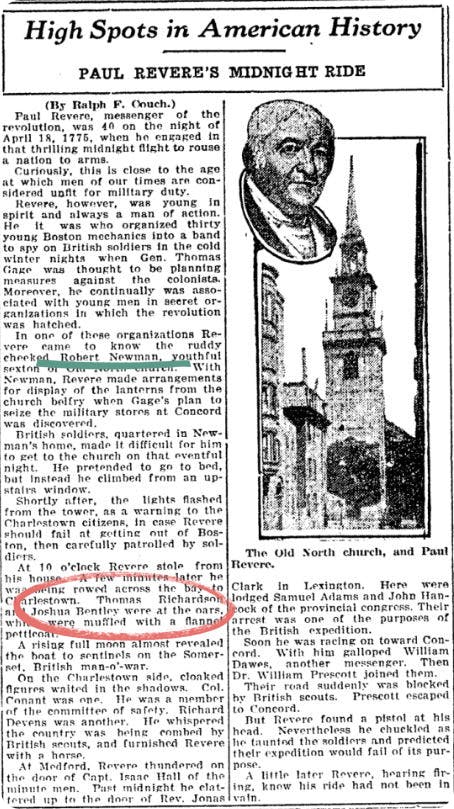
Quincy Daily Herald, May 21, 1917.
These men helped row him silently across the Charles River without being seen by any British ships. Fischer highlights an amusing legend about the help of a third party:
""Another folktale has it that as Bentley and Richardson prepared to launch the boat, they discovered that they had forgotten a cloth to muffle their oars. The two men knocked softly at a nearby house. A woman came to an upper window, and they whispered an urgent request. There was a quick rustle of petticoats in the darkness, and a set of woolen underwear came floating down to the street. The lady's undergarments, still warm from the body that had worn them, were wrapped snugly round the oars.""
Please let us know on Facebook, Instagram or Twitter if your research has been able to verify this rather incredible part of the story!
The men at Charlestown, having seen the lantern, were ready to receive Revere at the shore and had a horse waiting for him.
John Larkin, a deacon of the Congregational Church, supplied Revere with Brown Beauty, one of the fastest horses in Charlestown and the pride of the Larkin family. Her speed came in handy early on in his journey. Soon after departing, he was chased by two soldiers who were left behind by Brown Beauty.
Thanks to the help of his friends, Revere was finally off to warn the countryside. Along the way, he encountered some men who aided him greatly. He crossed paths with two doctors at different points – Samuel Prescott and Martin Herrick – and they volunteered to become riders themselves. Both men were used to riding the countryside at night and could plausibly excuse their late night trips under the guise of their profession.
Local Whig leaders also played key roles. In the town of Medford, Revere quickly checked in with local militia captain Isaac Hall, who raised the town's alarm himself, allowing Revere to continue. He had similar contact with Richard Devens in Charlestown, Ebenezer Stedman in Cambridge, as well as Benjamin Locke and Solomon Bowman in Menotomy.
And of course, each of these leaders threw their own communities into action. Rider after rider was sent out until the entire countryside was prepared for the Regulars – who were themselves making a very slow approach. When all was said and done, a whole lot more than just twelve people were involved in making the Midnight Ride a success.
Without the help of everyday people, Paul Revere never would have made it out of Boston. And if he rode through the countryside alone knocking on individual farmhouse doors himself, much of the countryside would have been made aware far too late.
The Ride of Paul Revere serves as a fascinating reminder that history isn't just made by great men. Our ancestors, regardless of their historical fame, are worthy of being viewed as agents of historical change. You can discover more about Revere, his life and escapades in the many articles included in the PERiodical Source Index.
The main source for this article is David Hackett-Fischer's meticulously researched Paul Revere's Ride. It's an amazing work of history that is a must-read for anyone interested in exploring colonial America.
Related articles recommended for you
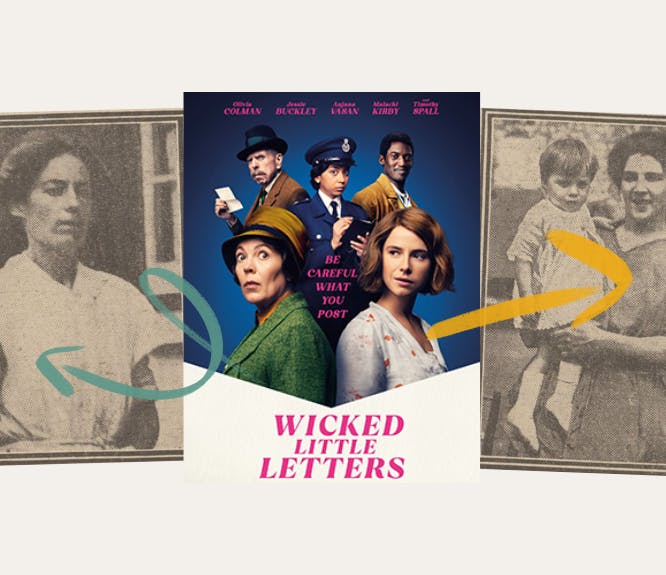
The shocking true story behind Wicked Little Letters
History Hub
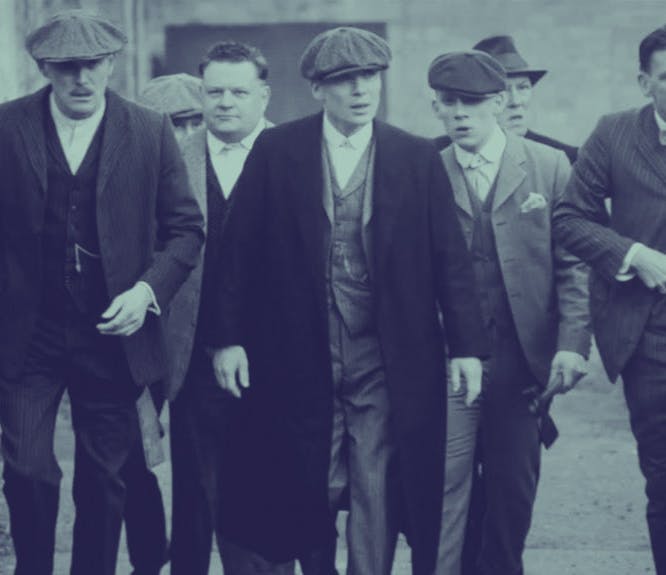
Who were the real Peaky Blinders?
Discoveries
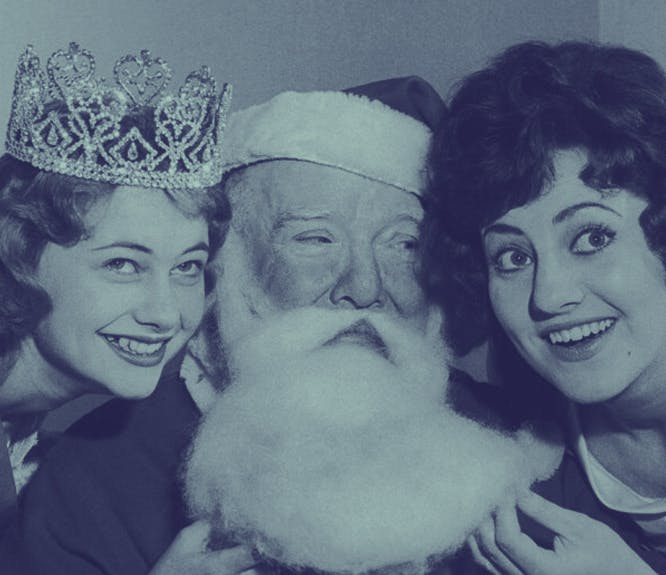
How old is Santa Claus?: Santa's family tree goes back further than you might think
Build Your Family Tree
